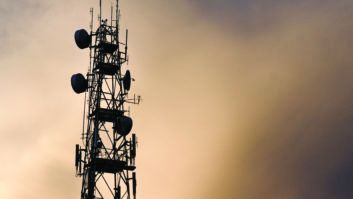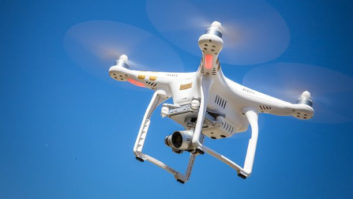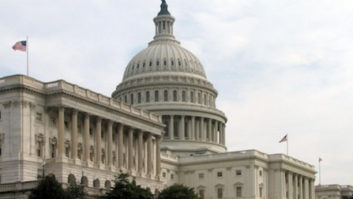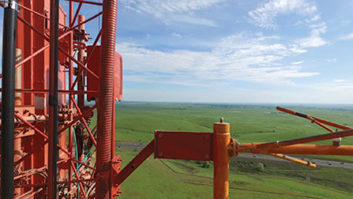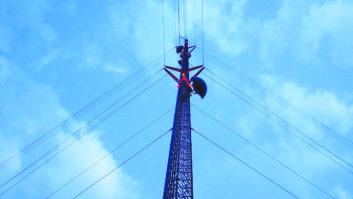WASHINGTON New Federal Aviation Administration tower rules take effect in January. While the immediate impact on radio and television owners with towers will be limited, experts also say the door has been left open for tougher FAA scrutiny of electromagnetic interference from the FM radio band to aviation communications.
After the FAA proposed rule changes in 2006, broadcasters and tower owners had feared more involvement from the FAA and the Department of Transportation for future tower projects or modifications, according to industry watchers. However, the FAA appears to have backed off much of its initial effort to bring a wide range of broadcast applications under its control.
The original proposal would have meant increased notification requirements for stations, expanded to include construction of new facilities that operate in specified frequency bands, addition of newer frequencies, increases in effective radiated power or antenna height above certain thresholds and changes in authorized frequency.
(click thumbnail)
Determining whether a station is not a hazard to aviation can be costly. These graphics are from work by Hammett & Edison in 1994 for a Class A FM that had received an FAA ‘hazard’ determination on EMI grounds. The station was directional. H&E was able to show that the Airspace Analysis Model software that the FAA was using neglected to square the relative field value of the azimuth pattern. Once this was done, H&E said, the predicted interference disappeared and the FAA withdrew its objection; but the process cost the station several thousand dollars in engineering fees. The FAA said it wanted to simplify and modernize its rules.
At the time, broadcast advocates considered the rulemaking request to be particularly onerous for stations. However, the final Report and Order published in the Federal Register (FAA Docket 25002) earlier this year is far less restricting, observers said.
Existing rules state that any tower taller than 200 feet above ground level or that may interfere with the flight path of a nearby airport requires FAA notification and FCC registration on the FCC’s Antenna Structure Registration (ASR) system.
The FAA’s “Safe, Efficient Use and Preservation of the Navigable Airspace,” released in 2010, outlines minor updates to federal rules for broadcasters with towers near airports who want to modify their existing towers or plan new construction.
However, the new rules, which take effect Jan. 18, 2011, leave open future deliberations over electromagnetic interference between FM broadcasts and navigation signals.
“Therefore, the threat of further intrusion by the FAA into RF matters still exists,” one legal observer said.
FAA EMI concerns
The FAA has expressed growing concern with the impact of electromagnetic interference (EMI) on aeronautical operations from broadcast services operating in the 88–107.9 MHz FM frequency band. It has said FM frequencies “pose the greatest concern to FAA navigation signals.” The FM band is adjacent to the navigation communications band (108–136.5 MHz).
In its report, the FAA said it will work with the FCC, which historically has had final say over spectrum management issues, and the National Telecommunications and Information Administration on the best way to address electromagnetic interference issues.
Broadcasters can expect the FCC and FAA to reach a collaborative decision on proposed frequency notice requirements and proposed EMI obstruction standards, according to the FAA’s rulemaking.
“The major potential problems the FAA’s initial proposal raised for broadcasters have been eliminated, or at least tabled for the time being,” said Harry Cole, a communications attorney with Fletcher, Heald & Hildreth and a Radio World columnist. “The FAA is currently negotiating the FM matter with the FCC.”
Meanwhile, the commission wants to modernize its own Part 17 tower lighting and obstruction rules. An agency spokesman said the commission is “still working” on the Notice of Proposed Rulemaking (Docket WT 10-88) released in 2010. The reply comment period closed in August.
“I imagine the FCC will move forward reasonably quickly to clear up a number of inconsistent and outdated rules. There did not appear to be any major changes from the NPRM,” Cole said.
Of the FAA rule modifications governing broadcast towers, the most significant, according to experts, involves the FAA’s Determinations of Hazard or No Hazard.
A Determination of No Hazard from the FAA indicates that a broadcast tower will not interfere with planes or radio navigation aids. The FCC requires tower owners to obtain a valid “no hazard” determination from the FAA before registering with the commission.
Under the new rule, an FAA Determination of Hazard or Determination of No Hazard is effective 40 days after it is issued; previously, the effective date was the day it was issued.
Several experts said this change conceivably could slow a tower project. However, they added that the new rules likely would prove inconsequential to most broadcasters who plan projects correctly.
The final rule also stipulates that a Determination of No Hazard to air navigation will expire 18 months after it takes effect, or when the proposed construction or alteration is abandoned.
Previously, the rules allowed indefinite extension of a “no hazard” determination under certain circumstances. As a result, if an FCC application took years to resolve, the FAA had to keep protecting airspace for a tower that might never be built.
The new rules allow extensions but they won’t be automatic. An applicant will have to request extensions and make its case each time. That’s a concern for tower owners, because once a “no hazard” determination expires, there is no guarantee of reinstatement, especially if circumstances have changed. This also creates an additional regulatory burden on the broadcaster or tower owner, who must remember to file a timely extension application for the expiring “no hazard” determination.
FM Still on FAA’s Radar The FAA’s original proposal would have affected radio frequency transmissions operating on the following frequencies:
(i) 54–108 MHz
(ii) 150–216 MHz
(iii) 406–430 MHz
(iv) 931–940 MHz
(v) 952–960 MHz
(vi) 1390–1400 MHz
(vii) 2500–2700 MHz
(viii) 3700–4200 MHz
(ix) 5000–5650 MHz
(x) 5925–6525 MHz
(xi) 7450–8550 MHz
(xii) 14.2–14.4 GHz
(xiii) 21.2–23.6 GHz
The FAA has now concluded that its original proposal was too broad.
But it says FM transmissions in the 88.0–107.9 MHz frequency band pose the greatest concern to FAA navigation signals. The FAA, FCC and NTIA are collaborating on the best way to address this issue. Therefore, proposals on FM broadcast service transmissions in the 88.0–107.9 MHz frequency band remain pending, according to the FAA. The new rule also further expands the requirements for notice to be sent to the FAA for proposed construction or alteration of structures on or near private use airports that have an Instrument Approach Procedure (IAP).
“That is a potential ‘gotcha’ for broadcasters,” said Dane Ericksen, consulting broadcast engineer with Hammett & Edison. “IAPs at private use airports are not currently listed in any aeronautical publication, which means the FCC TOWAIR program is unlikely to detect a private use airport with an IAP.” Ericksen recommends that those who want to build new towers check the FAA website for compliance.
Unwanted ‘poster child’
Several broadcasters and engineering consultants wrote in during the 2006 NPRM comment period, arguing that the modifications would overlap with rules the FCC already had in place regulating the same area.
“Indeed, the FAA’s proposal is a virtual ‘poster child’ of federal rules which may duplicate, overlap or conflict with FCC rules,” wrote the Society of Broadcast Engineers in its comments.
In joint comments, Entercom Communications, Beasley Broadcast Group and CBS Radio spoke of unnecessary additional burdens that would be placed on broadcasters if the FAA adopted the proposals, and they asked the FAA to follow its statutory obligation to coordinate with the FCC prior to the implementation of new notice requirements.
“The FAA says it isn’t their intent to add a duplicative review and coordination process to that of the FCC, but that is belied by the nature of their original proposal,” said Erik Swanson of Hatfield & Dawson Consulting Engineers. “They were asking to have their hand on just about anything you did on a broadcast tower, including changes that do not require prior FCC approval.”
Another broadcast engineering consultant who follows regulatory matters said the FAA historically has set its own standards, not always consistent with those of the FCC. However, both agencies share the same basic concerns over air safety.
“The FCC has tried to cooperate with the FAA,” the consultant said. “Congress has specifically delegated responsibility for spectrum regulation to the FCC. But the FAA must be able to control any use of radio spectrum that might affect air traffic safety. Any regulated industry, such as broadcasting, has reason to be concerned when two government agencies attempt to impose conflicting standards.”
Ellen Crum, director of the FAA’s Air Traffic Systems Operations, Airspace and Rules Group, has led the FAA’s efforts to modernize their rules governing broadcast towers, according to observers.

